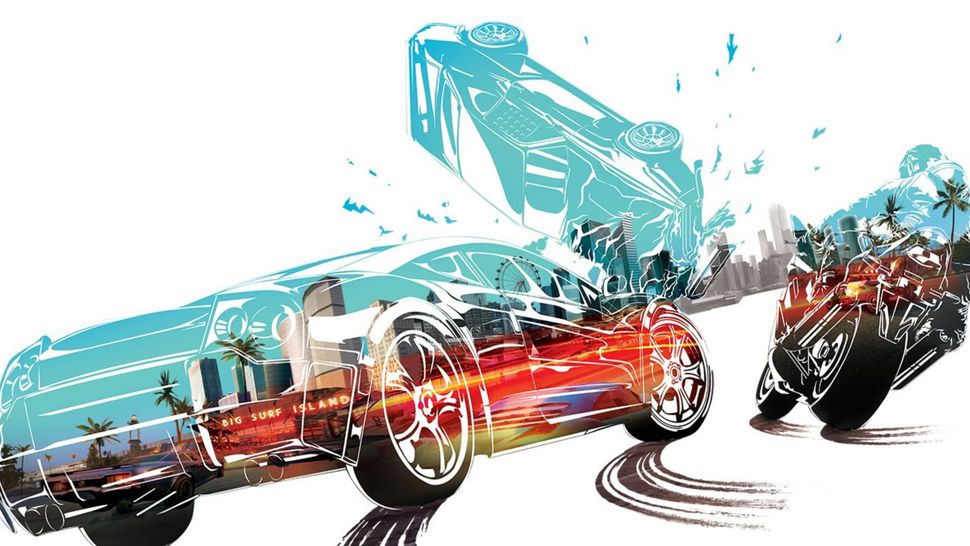
There’s something about finally landing a jump onto an aircraft hangar, only to teeter on the edge and flop unceremoniously down onto a friend who’s playing hide-and-seek in a miniature car, that makes you appreciate the silliness of Burnout Paradise. Taking the game away from the typical racing structure and setting it in an open world was a move lauded by many critics and fans, and kept me playing for hours.
Paradise kept the series’ impactful racing, but added diversions that made it feel like a brand-new experience—perfect for PC players coming to Burnout for the first time. Despite not being a petrolhead, it was astonishingly easy for me to fall in love with, because the freedom to faff about in games makes my heart sing.
Eschewing the traditional driving game frameworks of tracks and rigid race-based progression, Paradise instead delivers a liberating experience. The sense of freedom the game hands out as you settle into its bright and breezy city is heady. It’s perfect for a more lackadaisical gamer like myself, letting me meander around the tarmac playground, doing whatever I feel like and, crucially, in whatever order. Or doing nothing substantial at all. With no pressure to achieve a damn thing of note, I can while away the hours doing stunt runs on the beach, or simply park on top of a hangar in the airfield and watch the day and night cycles do their thing.

I’ve spent afternoons being a Sunday driver, pootling around the White Mountains, listening to Beethoven and shouting abuse at bus drivers. I’ve gone careening around the streets in a truck that handles like a fridge, on a mission to ding every parked car in sight.
I’ve spent afternoons being a Sunday driver, pootling around the White Mountains, listening to Beethoven and shouting abuse at bus drivers.
It’s like Criterion took the stupid stuff that people do for fun in games and made that the whole point. Trash stuff? Do stunts in bizarre locations? See how many of your mates can cram themselves into one tiny spot? Play hide-and-seek? Abuse city parking facilities? Here, Criterion will get that for you, and then some.
The freedom does, however, come at the price of having to read a map properly—something few Burnout players I’ve ever played online with can do with any degree of accuracy. In a world this big, it can lead to screams of, “Where is it!?”, and nagging party members who need your presence in order to complete one of the low stakes multiplayer challenges. And there’s always some idiot who goes to the airfield when they’re meant to be at the quarry.
And don’t start me on the purgatory of the I-88 freeway—hard to get on and near-impossible to get off. If you misread the minimap and accidentally find yourself on there… well, may the gods be with you. I believe there are still phantoms of lost players endlessly drifting around, searching for one of its exits.

There is busywork—lots of it—but it’s optional. And if I do decide to progress through the campaign, I have the freedom to select what I want from a pick-and-mix of challenges and activities. I’m not forced into the same race, suffering outrageous rubber banding AI and frustrating progression curves. If I bugger up by driving into the side of a bus, then I can sulk off into a Road Rage or Stunt Run instead—taking out my aggression by running cars off the road for points, or by comboing outrageous manoeuvres.
The first Burnout to come to PC isn’t all sunshine, however. PC gamers, until the recently announced remaster, have been denied the DLC and car packs that their console counterparts have enjoyed, which is a massive oversight. Big Surf Island was a chunky bonus playground, with challenges of its own, and its loss, along with the legendary vehicles, is something PC gamers have, until now, had to fi x by way of mods or workarounds.
A game this enjoyable, with so much player freedom should have had a sequel long before now. Instead, we’re getting a shiny remaster, which is something. Still, who knows what the future may hold for the series? Hopefully it’s not just a bus-shaped loot box.
[“Source-pcgamer”]